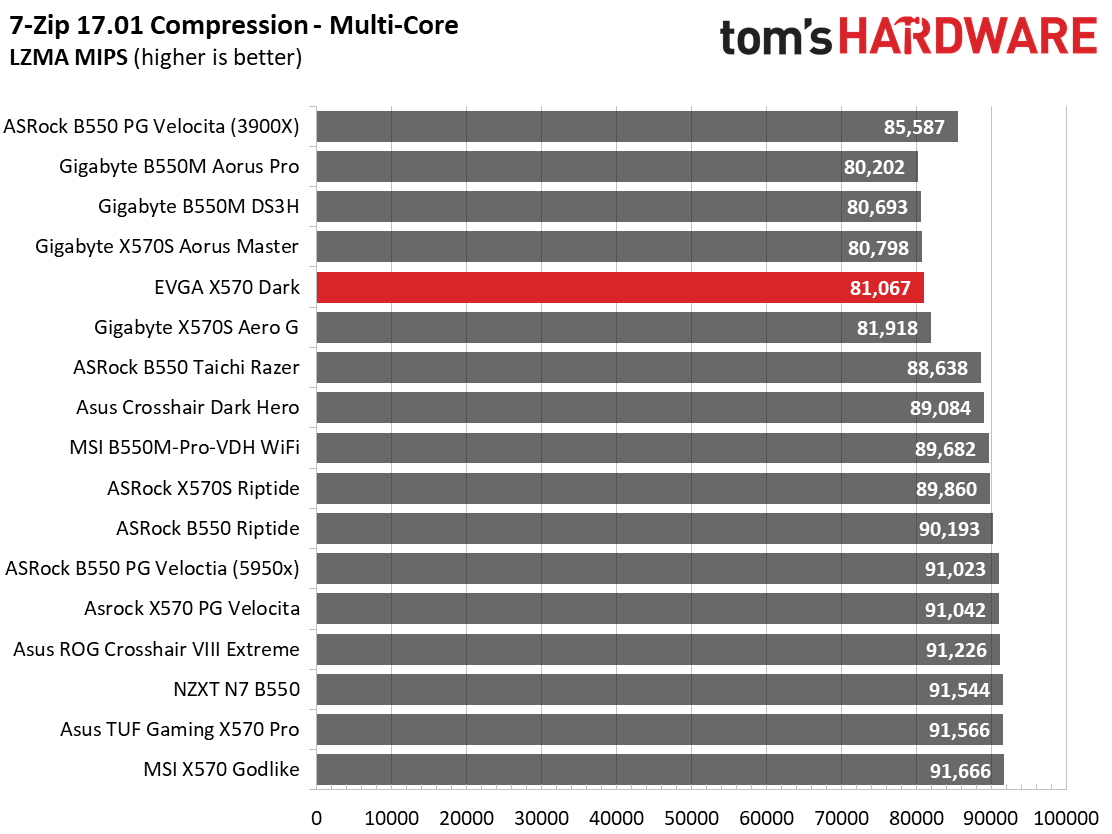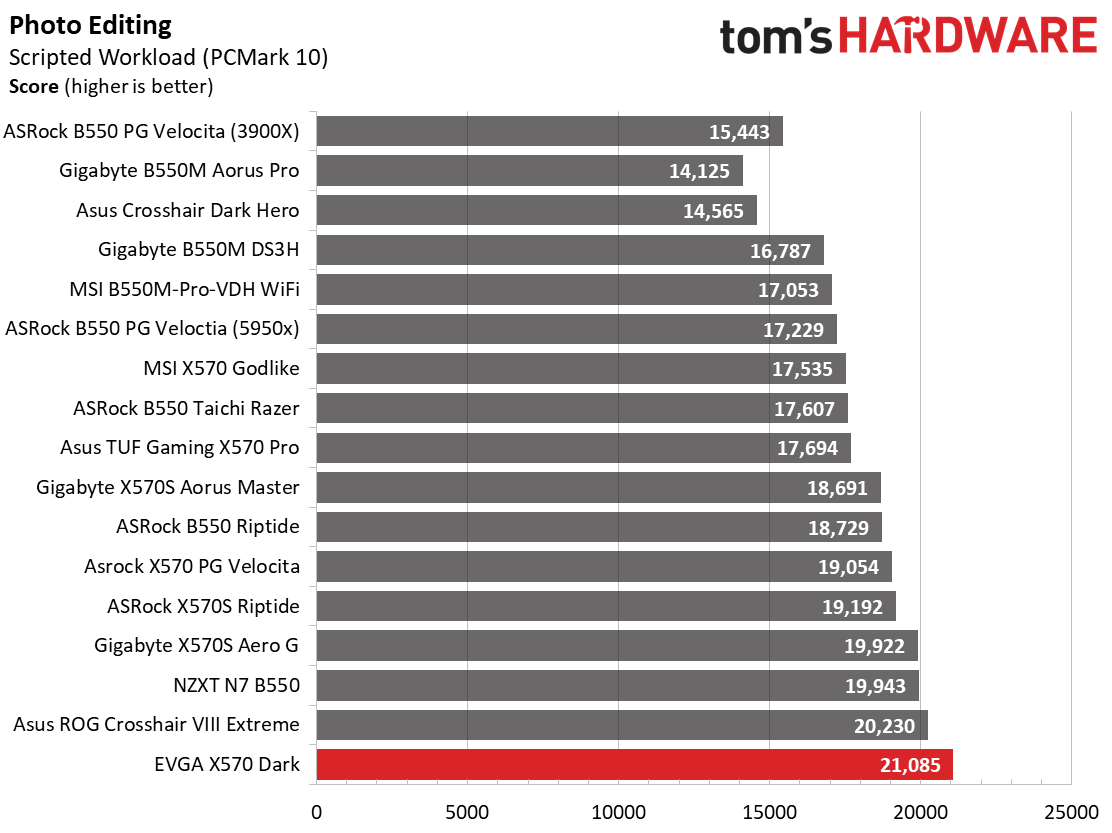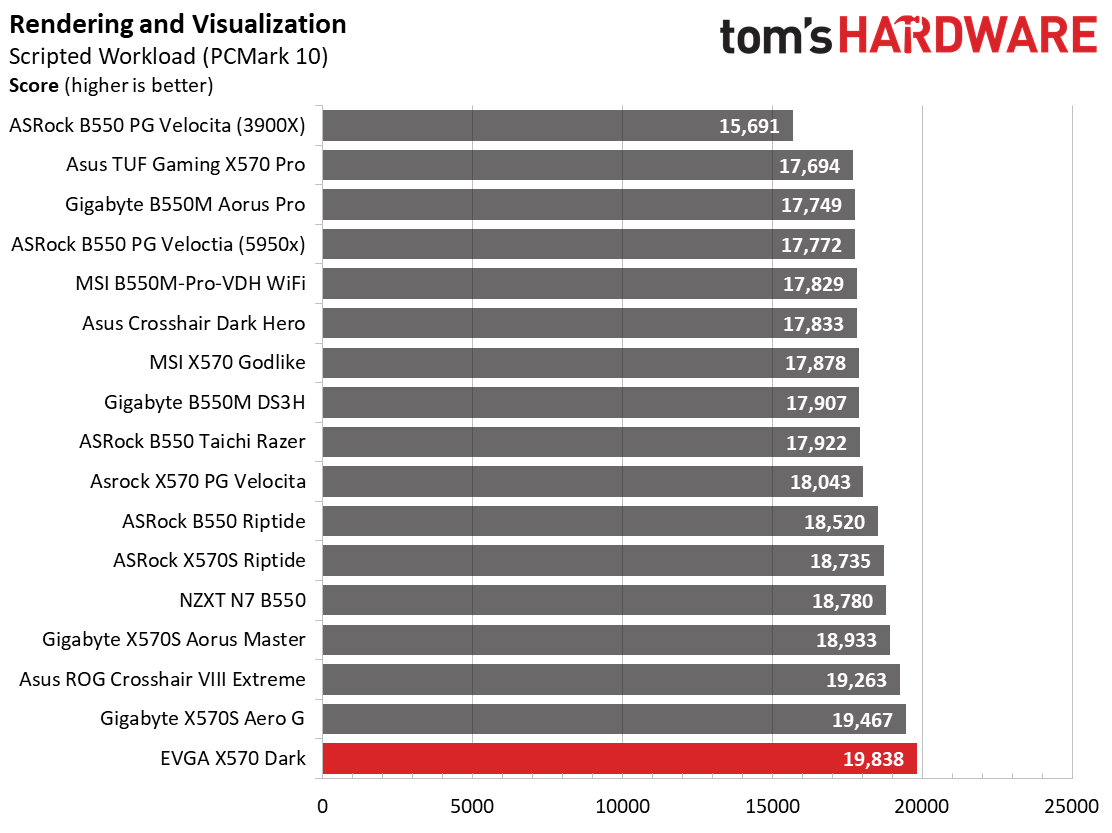Why you can trust Tom's Hardware
Our standard benchmarks and power tests are performed using the CPU’s stock frequencies (including stock Thermal Velocity Boost), with all power-saving features enabled. Optimized defaults are set in the BIOS and the memory set using the XMP profiles. For this baseline testing, Windows is set to High Performance before switching over to Balanced during power testing, so the PC idles appropriately.
Synthetic Benchmarks
Synthetics are a great tool to determine if a board runs out of spec, as identical settings should produce similar performance results. Advanced memory timings are the one place where motherboard makers can still optimize for either stability or performance, though, and those settings can impact some testing.





















Starting with 7Zip, the Dark performed inconsistently. In the compression tests, the Dark was below the average and grouped with several similarly performing boards. On the decompression side, it popped the highest score we’ve seen (by almost 2%) so far. Cinebench results were solid, with the multi-core performance the fastest result we’ve seen so far, while single-core performance was average. The same goes for POV-Ray: Multi-core performance was the highest we’ve seen while the single-core was around average. The Dark’s performance in the PCMark 10 Suite was excellent, with most scores well above average (or the fastest tested so far). In the end, the board favored heavily multithreaded tests, while being at or close to average for single-threaded benchmarks.
Timed Applications




For timed applications, the Dark was on the faster side of average in LAME, posting a time of 11.76 seconds (average is 11.95 seconds). In the Corona Ray-Tracing benchmark, our system ran it in 33 seconds which is the fastest result we’ve seen at this time by one second (around 2% faster than the next set of results). Handbrake results were split between x264 and a bit slower than the average, while x265 results were one of the fastest we’ve seen.
The trend we’re seeing is that this board performs well with multi-threaded tests, but single-threaded tests tend to fall just slightly at or below average.
3D Games and 3DMark




Starting with the X570S chipset launch, we’ve updated our game tests and hardware (video card) to match the Intel platform. We stopped using The Division 2 and Forza Horizon 4 and now use Far Cry: New Dawn and F1 2020, using the Asus TUF Gaming RTX 3070. Games are run at 1920x1080 resolution using the Ultra preset. As the resolution goes up, the CPU tends to have less of an impact. The goal with these settings is to determine if there are differences in performance at the most commonly used resolution with settings most people use or at least strive for.
We saw appreciable gains during our gaming tests when moving from the 3900X to the newer 5950X in these new titles. Between the clock speeds, IPC and significant cache differences, performance increased using this CPU at our 1080p test resolution. If you game at a higher resolution, chances are you won’t see those gains unless you’re using one of the new, ultra-fast Nvidia or AMD GPUs. In 3DMark Fire Strike and Time Spy, the Dark performed well in both tests scoring above average in each.
Get Tom's Hardware's best news and in-depth reviews, straight to your inbox.
We know this Ryzen-based system can push the RTX 3070 to its fullest potential when looking at the games. In F1 2020, the Dark averaged 211 FPS, which is more than our Rocket Lake-based system and negligibly below the average (212 FPS) for AMD boards. Far Cry averaged 131 FPS, which is right on par. If you get bored of tweaking and overclocking, this board is a competent gaming rig foundation, too.
Power Consumption / VRM Temperatures
We used AIDA64’s System Stability Test with Stress CPU, FPU and Cache enabled for power testing, using the peak power consumption value. The wattage reading is from the wall via a Kill-A-Watt meter to capture the entire ecosystem. The only variable that changes is the motherboard; all other parts are the same.
The X570 Dark idled at 80W, one of the higher results of boards tested. Load peaked at 250W, a mere 1W below the highest value we’ve seen. The average between idle and load, 165W, is the second-highest we’ve recorded so far. If peak efficiency out of the box is what you’re looking for, you should look elsewhere. But again, this is an overlocking board, so efficiency isn’t its aim.




The X570 Dark’s 90A Vcore MOSFETs handled our Ryzen 5950X without issue at both stock and while overclocked to 4.4 GHz. The VRMs peaked at around 44 degrees Celsius on the probes during stock operations, while the integrated sensor on the board peaked at roughly 48C. This is one of the cooler results we’ve seen, an expected outcome from an actively cooled VRM. While overclocked, the VRMs peaked at 47 degrees Celsius, another result on the cooler side of things. The large finned heatsinks and active cooling did their job and kept temperatures low. As far as fan noise, I could only hear them ramp up when powering on. Otherwise, I couldn’t hear the fans(even while overclocked) over the AIO and system fan. Noise is nothing to worry about, nor are the VRMs.
Overclocking
There are several ways to overclock on AMD platforms, depending on your goals. If your focus is single-threaded performance, you may want to focus on using Precision Boost Overdrive (PBO) and adjusting its parameters. If you can use all cores and threads, setting a manual CPU multiplier and voltage is likely the better route. While the latter clips peak single-threaded performance slightly, it increases all core/thread performance over the all-core boost. To that end, we settled on 4.4 GHz at ~1.3V for an all-core/thread overclock.
The X570 Dark overclocked our 16-core/32-thread Ryzen 9 5950X without issue. We set the LLC at 50% and a fixed voltage of 1.3V, and away we went. There was still some Vdroop at this setting, but that’s expected as there are higher tiers to further mitigate the voltage drop if you choose.
On the memory side, we had no issues setting the memory to DDR4 3600. The Dark set this at 1:2 by default, but the performance was spot on with others running the same. We didn’t overclock the memory, but the potential is certainly there, as shown in the screenshot above.
Final Thoughts
EVGA dipping its toes in the AMD realm was a shock to many, but here we are with a flagship-class X570 based board in hand, or at least on the test bench. The Z590 Dark tested well and is built like a tank, much like this AMD-based offering. The X570 Dark changes socket orientation for shorter traces and better cable management, has overbuilt VRMs, and two memory slots. But it’s not all about overclocking. Thebaord is a well-rounded solution and comes with eight SATA ports, two M.2 sockets, and is one of the rare X570 boards that officially supports Nvidia SLI technology. Priced at $689.99, the budget crowd need not apply. If you get choked up over the cost, we understand. But don’t fret! EVGA says anX570 FTW is on the way, which will be more affordable.
We know performance is spot on and even above average in multi-threaded testing, so if you plan on using this as your daily driver to do work, you’ll get what you paid for and extract the most from whatever processor you decide to use. Gaming results were also solid, making this board a good performer overall.
It’s not without its drawbacks, though. The Dark falls short in M.2 socket count and only runs PCIe-based modules. While not a dealbreaker, other boards around this price have three or more, with at least one that supports SATA M.2 modules (see the competition below). The seven total USB ports, on the rear IO may be light for some, but there’s always the front panel and other headers if that’s an issue. Considering how late the board was released, I would like to have seen the latest audio codec and Wi-Fi 6E. But like the M.2 sockets, these aren’t dealbreakers for most users. And again, it’s an overclocking board and Wi-Fi 6 is plenty fast anyway.
As far as competition goes, there isn’t a plethora high-end overclocking-focused motherboard in the X570 (or B550) space. But around this price, there are a couple. First, from Gigabyte is the flagship X570 Aorus Xtreme ($799.99 MSRP), and Asus chimes in with the new Crosshair VIII Extreme ($799.99 MSRP). The MSI X570 Godlike Gaming ($699.99 MSRP) lands in this mix as well. With the exception of the Crosshair VIII Extreme, the other boards released at/right around X570 launch day, and so they tend to have last-gen hardware, as does the Dark. Otherwise, it’s a trade-off of features between them.
All these boards sport robust power delivery and are capable of overclocking hardware to their limits, even with sub-ambient cooling methods. It comes down to hardware preference, looks, and price as to which to choose, as they are all excellent flagship-class options and come loaded with features. Pricing is on the Dark’s side as the cheapest of the comparables, although MSI’s offering is just $10 more.
The X570 Dark is significant as EVGA’s first AMD board, and a shot across the bow to the other board partners. It’s stable out of the box and didn’t feel like a work in progress at release — something EVGA has improved upon over the years. If you’re looking for a high-end motherboard and have $690 to spend, the EVGA X570 Dark is a well-appointed option for the overclocker and enthusiast looking to build an AMD Ryzen based PC. Welcome to AMD, EVGA. We’re happy you’re here.
MORE: Best Motherboards
MORE: How To Choose A Motherboard
MORE: All Motherboard Content

Joe Shields is a staff writer at Tom’s Hardware. He reviews motherboards and PC components.
-
hotaru251 to be honest....this board is basically made for XOC....so none of those "cons" are actually cons in the target demographic.Reply -
slash3 Mentioning SLI support as being rare on X570 is super weird. There are no fewer than 26 X570 based motherboards which support SLI listed in the community AM4 motherboard database spreadsheet, and it hasn't even been updated with the X570 Dark yet.Reply
https://docs.google.com/spreadsheets/d/1wmsTYK9Z3-jUX5LGRoFnsZYZiW1pfiDZnKCjaXyzd1o/ -
Alvar "Miles" Udell This is a motherboard which is advertised to basically be only for extreme overclocking and will be better at overclocking than every other board out there, except maybe the X570 Godlike which you have to be mental to consider, since you can have far more utility and features from several other boards, yet I can't help but notice in the Overclocking section there wasn't a comparison of overclocking results for the same 5950X across a selection of X570S motherboards across a variety of applications...Reply -
jj1010 I'm sure it's a great board and all...but when I look at that heatsink all I can see is "DORK" instead of "DARK".Reply
I...I will show myself out... -
taz-nz Reply
Probably referring to the 4 slot spacing (slot 2 & 6) required for SLI with RTX 3090 , Basically all nvlink bridges for the RTX3090 are 4 slot designs, 3 slots bridge do exist but are hard to find.slash3 said:Mentioning SLI support as being rare on X570 is super weird. There are no fewer than 26 X570 based motherboards which support SLI listed in the community AM4 motherboard database spreadsheet, and it hasn't even been updated with the X570 Dark yet.
https://docs.google.com/spreadsheets/d/1wmsTYK9Z3-jUX5LGRoFnsZYZiW1pfiDZnKCjaXyzd1o/ -
Howardohyea really looks like they just took the Z590 board design and just smacked AMD stuff on, but nevertheless it's an interesting board (and by that I mean reading reviews since most likely none of us will ever get our hands on one of those)Reply

